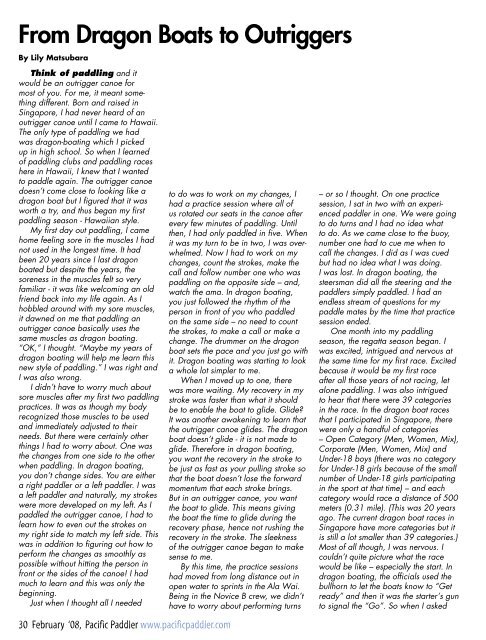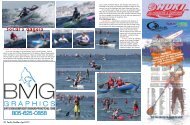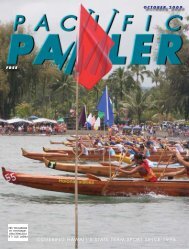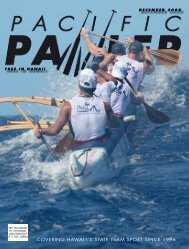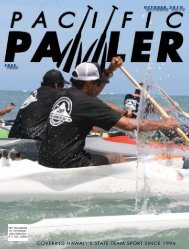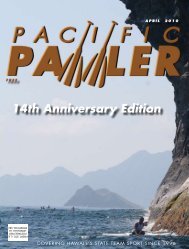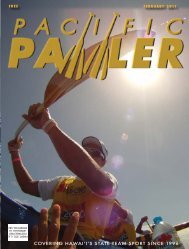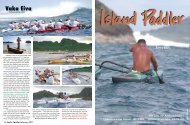covering hawai'i's state team sport since 1996 - Pacific Paddler
covering hawai'i's state team sport since 1996 - Pacific Paddler
covering hawai'i's state team sport since 1996 - Pacific Paddler
You also want an ePaper? Increase the reach of your titles
YUMPU automatically turns print PDFs into web optimized ePapers that Google loves.
From Dragon Boats to Outriggers<br />
By Lily Matsubara<br />
Anuenue’s Novice B Mixed crew with Lily<br />
stroking the MacFarlane race<br />
Think of paddling and it<br />
would be an outrigger canoe for<br />
most of you. For me, it meant something<br />
different. Born and raised in<br />
Singapore, I had never heard of an<br />
outrigger canoe until I came to Hawaii.<br />
The only type of paddling we had<br />
was dragon-boating which I picked<br />
up in high school. So when I learned<br />
of paddling clubs and paddling races<br />
here in Hawaii, I knew that I wanted<br />
to paddle again. The outrigger canoe<br />
doesn’t come close to looking like a<br />
dragon boat but I figured that it was<br />
worth a try, and thus began my first<br />
paddling season - Hawaiian style.<br />
My first day out paddling, I came<br />
home feeling sore in the muscles I had<br />
not used in the longest time. It had<br />
been 20 years <strong>since</strong> I last dragon<br />
boated but despite the years, the<br />
soreness in the muscles felt so very<br />
familiar - it was like welcoming an old<br />
friend back into my life again. As I<br />
hobbled around with my sore muscles,<br />
it dawned on me that paddling an<br />
outrigger canoe basically uses the<br />
same muscles as dragon boating.<br />
“OK,” I thought. “Maybe my years of<br />
dragon boating will help me learn this<br />
new style of paddling.” I was right and<br />
I was also wrong.<br />
I didn’t have to worry much about<br />
sore muscles after my first two paddling<br />
practices. It was as though my body<br />
recognized those muscles to be used<br />
and immediately adjusted to their<br />
needs. But there were certainly other<br />
things I had to worry about. One was<br />
the changes from one side to the other<br />
when paddling. In dragon boating,<br />
you don’t change sides. You are either<br />
a right paddler or a left paddler. I was<br />
a left paddler and naturally, my strokes<br />
were more developed on my left. As I<br />
paddled the outrigger canoe, I had to<br />
learn how to even out the strokes on<br />
my right side to match my left side. This<br />
was in addition to figuring out how to<br />
perform the changes as smoothly as<br />
possible without hitting the person in<br />
front or the sides of the canoe! I had<br />
much to learn and this was only the<br />
beginning.<br />
Just when I thought all I needed<br />
to do was to work on my changes, I<br />
had a practice session where all of<br />
us rotated our seats in the canoe after<br />
every few minutes of paddling. Until<br />
then, I had only paddled in five. When<br />
it was my turn to be in two, I was overwhelmed.<br />
Now I had to work on my<br />
changes, count the strokes, make the<br />
call and follow number one who was<br />
paddling on the opposite side – and,<br />
watch the ama. In dragon boating,<br />
you just followed the rhythm of the<br />
person in front of you who paddled<br />
on the same side – no need to count<br />
the strokes, to make a call or make a<br />
change. The drummer on the dragon<br />
boat sets the pace and you just go with<br />
it. Dragon boating was starting to look<br />
a whole lot simpler to me.<br />
When I moved up to one, there<br />
was more waiting. My recovery in my<br />
stroke was faster than what it should<br />
be to enable the boat to glide. Glide<br />
It was another awakening to learn that<br />
the outrigger canoe glides. The dragon<br />
boat doesn’t glide - it is not made to<br />
glide. Therefore in dragon boating,<br />
you want the recovery in the stroke to<br />
be just as fast as your pulling stroke so<br />
that the boat doesn’t lose the forward<br />
momentum that each stroke brings.<br />
But in an outrigger canoe, you want<br />
the boat to glide. This means giving<br />
the boat the time to glide during the<br />
recovery phase, hence not rushing the<br />
recovery in the stroke. The sleekness<br />
of the outrigger canoe began to make<br />
sense to me.<br />
By this time, the practice sessions<br />
had moved from long distance out in<br />
open water to sprints in the Ala Wai.<br />
Being in the Novice B crew, we didn’t<br />
have to worry about performing turns<br />
– or so I thought. On one practice<br />
session, I sat in two with an experienced<br />
paddler in one. We were going<br />
to do turns and I had no idea what<br />
to do. As we came close to the buoy,<br />
number one had to cue me when to<br />
call the changes. I did as I was cued<br />
but had no idea what I was doing.<br />
I was lost. In dragon boating, the<br />
steersman did all the steering and the<br />
paddlers simply paddled. I had an<br />
endless stream of questions for my<br />
paddle mates by the time that practice<br />
session ended.<br />
One month into my paddling<br />
season, the regatta season began. I<br />
was excited, intrigued and nervous at<br />
the same time for my first race. Excited<br />
because it would be my first race<br />
after all those years of not racing, let<br />
alone paddling. I was also intrigued<br />
to hear that there were 39 categories<br />
in the race. In the dragon boat races<br />
that I participated in Singapore, there<br />
were only a handful of categories<br />
– Open Category (Men, Women, Mix),<br />
Corporate (Men, Women, Mix) and<br />
Under-18 boys (there was no category<br />
for Under-18 girls because of the small<br />
number of Under-18 girls participating<br />
in the <strong>sport</strong> at that time) – and each<br />
category would race a distance of 500<br />
meters (0.31 mile). (This was 20 years<br />
ago. The current dragon boat races in<br />
Singapore have more categories but it<br />
is still a lot smaller than 39 categories.)<br />
Most of all though, I was nervous. I<br />
couldn’t quite picture what the race<br />
would be like – especially the start. In<br />
dragon boating, the officials used the<br />
bullhorn to let the boats know to “Get<br />
ready” and then it was the starter’s gun<br />
to signal the “Go”. So when I asked<br />
my paddle mates what the starting was<br />
like, I had a difficult time imagining the<br />
flags going “yellow, yellow, yellow,<br />
red, green”. I was used to “hearing”<br />
the start and not “looking” at the start,<br />
and because I was sitting in one, I was<br />
a little worried.<br />
With this mix of excitement and<br />
nervousness, the first race day arrived.<br />
What a relief it was when I learned<br />
that there would be boat holders and<br />
the boat holder would watch the flags<br />
and yell us the “Go!” - it was one less<br />
thing for me to worry about. With my<br />
adrenalin running at the start line, I<br />
hit the water with the “Go!” and went<br />
all the way to the finish – that was my<br />
mistake. My dragon boating instinct<br />
had kicked in when I hit the water. I did<br />
not stretch out my strokes after the first<br />
two changes to allow the boat to glide<br />
but instead, I upped my pace. My pull<br />
and my recovery were way too fast,<br />
especially for the guys in my crew. We<br />
did not get the speed we could have<br />
gotten if I had stretched out my strokes,<br />
and we were completely spent by the<br />
time we crossed the finish line. I had a<br />
lot to work on before the next race.<br />
With another week’s practice<br />
behind me, I looked forward to the<br />
second race at Kailua. The water was<br />
choppy and the waves were of decent<br />
size in Kailua that day. This time, I<br />
reined in my pace and remembered<br />
to stretch my strokes. What I didn’t<br />
foresee were the waves hitting the<br />
ama. A little more than halfway into<br />
the quarter mile, a wave hit our ama<br />
and we hulied. Needless to say, the<br />
Novice B crew had never experienced<br />
a huli before nor performed a huli drill.<br />
I saw the nose of the boat tilting to<br />
one side in slow motion and before I<br />
realized, we were in the water. With<br />
everyone safe, my concern was no<br />
longer about the race but on how to get<br />
the boat up. None of us knew what to<br />
do. We needn’t have worried though<br />
because in no time, the experienced<br />
paddlers from our club were diving into<br />
the water from the official’s boat with<br />
buckets in hand to help us out of our<br />
predicament. It was, in the words of a<br />
paddle mate, our “baptism by water”.<br />
And so, as the regatta season<br />
comes to a close, I look back to the<br />
last two months with fondness. There<br />
is so much to learn and not enough<br />
hours to practice, or so it seems. Yes,<br />
dragon boating and outrigger paddling<br />
are quite different indeed. Over and<br />
beyond the difference in how the<br />
dragon boat is built and the type of<br />
paddle used (as a paddle mate has<br />
said so very succinctly, paddling the<br />
dragon boat is like paddling with a<br />
2X4 board), I have found that paddling<br />
the outrigger canoe demands a solid<br />
understanding of the ocean and the<br />
skillful execution of the paddling techniques<br />
that go with it.<br />
Despite these differences, there<br />
is one thing that remains the same<br />
for me. It is the exhilarating joy and<br />
immense peace I get from being out in<br />
the water - everything else falls a far<br />
second. With my first regatta season<br />
just about behind me, I look forward<br />
to the distance season to begin. And I<br />
smile to think of what new experiences<br />
await me.<br />
Lily was born and raised in<br />
Singapore. She is currently working<br />
on a Master’s degree in Early<br />
Child Education at the University<br />
of Hawaii. Her crew was the first<br />
OHCRA alternate in the Novice<br />
B Mixed division for the State<br />
Championships this year.<br />
30 February ‘08, <strong>Pacific</strong> <strong>Paddler</strong> www.pacificpaddler.com www.pacificpaddler.com <strong>Pacific</strong> <strong>Paddler</strong>, February ‘08 31


